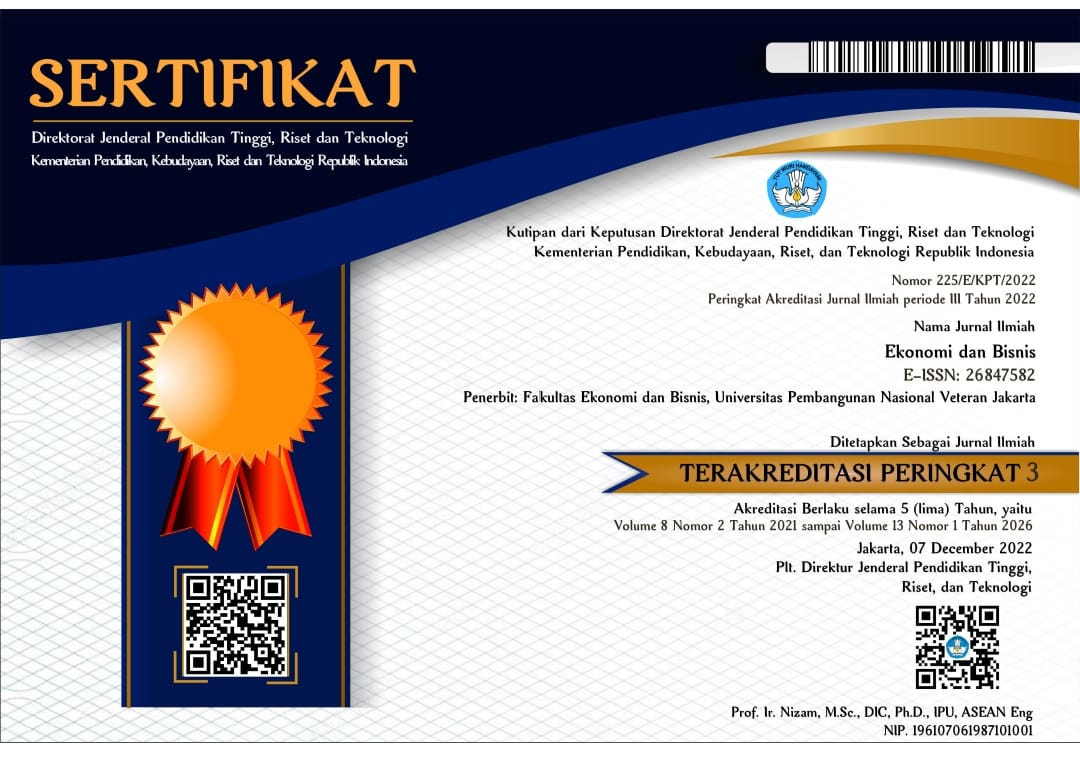Pengaruh Attitude Toward Behavior, Perceived Behavioral Control, dan Subjective Norm terhadap Entrepreneurial Intention Mahasiswa Non-Ekonomi
DOI:
https://doi.org/10.35590/jeb.v5i2.745Keywords:
Attitude Toward Behavior, Perceived Behavioral Control, Subjective Norm, Entrepreneurial IntentionAbstract
Entrepreneurship in Indonesia has been developing rapidly these past years. A survey among 210 university students without economic or business educational background showed that they also have an intention to be an entrepreneur and that their major in the university is not a barrier for them to start their own business. This study uses three independent variables which are attitude toward behavior, perceived behavioral control, and subjective norms to see the impact towards students’ entrepreneurial intention. Data was processed using PLS-SEM (Partial Least Square – Structural Equation Modeling). The finding of this study showed that attitude toward behavior, perceived behavioral control, and subjective norms have a significant impact towards students’ entrepreneurial intention. This study can be used by the government and universities to create programs that will increase the entrepreneurial spirit among students from various educational background and open opportunities for them to participate in entrepreneurial activities.
References
Ahmadi, Abu. (2009). Psikologi Sosial. Jakarta: PT RINEKA CIPTA.
Ajzen, I. (1991) The Theory of Planned Behavior. Organizational Behavior and Human Decision Processes, 50, 179-211.
Astuti, Rifelly Dewi dan Martdianty, Fanny. (2012). Students’ Entrepreneurial Intentions by Using Theory of Planned Behavior. Depok: The South East Asian Journal of Management. Vol. 6. No. 2.
Bird, B. (1988). Implementing Entrepreneurial Ideas: The Case for Intention. The Academy of Management Review, 13(3), 442–453.
Byabashaija, Warren dan Katono, Isaac. (2011). The Impact of College Entrepreneurial Education on Entrepreneurial Attitudes and Intention to Start a Business in Uganda. Journal of Developmental Entrepreneurship. Vol. 16. No.1. 127-144.
Fahmi, Irham. (2016). Kewirausahaan Teori, Kasus, dan Solusi. Bandung: Alfabeta.
Fayolle, Alain; Gailly, Benoit; dan Lassas-Clerc, Narjisse. (2006). Effect and Counter-effect of Entrepreneurship Education and Social Context on Student’s Intentions. Estudios de Economia Aplicada. Vol.24-2. 509-523.
Gelderen, Marco Van; Brand, Maryse; Praag, Mirjam Van; Bodewes, Wynand; Poutsma, Erik; dan Gils, Anita Van. (2008). Explaining Entrepreneurial Intentions by Means of The Theory of Planned Behaviour. Career Development International. Vol. 13 No. 6. 538- 559
Ghozali, Imam dan Latan, Hengky. (2015). PARTIAL LEAST SQAURES Konsep, Teknik Dan Aplikasi menggunakan Program SmartPLS 3.0 untuk penelitian empiris. Undip.
Hair, J.F., Hult, G. T. M., Ringle, C. M. & Sarstedt, M. (2014). A primer on partial least squares structural equation modeling (PLS-SEM). California: SAGE Publications, Inc.
Iakovleva, Tatiana; Kolvereid, Lars; dan Stephan, Ute. (2011). Entrepreneurial Intentions in Developing and Developed Countries. Education + Training. Vol 53. No. 5. 353-370.
Joensuu, Sanna; Viljamaa, Anmari; Varamaki, Elina; dan Tornikoski, Erno. (2013). Development of Entrepreneurial Intention in Higher Education nd The Effect of Gender – A Latent Growth Curve Analysis. Eduaction + Training. Vol 55. No. 8/9. 781-803.
Gartner, William B. and Katz, Jerome, Properties of Emerging Organizations (1988). Academy of Management Review, Vol. 13, Issue 3, p. 429-441.
Patiro, Shine Pintor S. dan Budiyanti, Hety. (2016). The Theory of Planned Behavior, Past Behavior, Situational Factors, and Self-Identity Factors Drive Indonesian Entrepreneurs to be Indebtedness. DeReMa Jurnal Manajemen. Vol 11. No. 1.
Prabandari, Sri Palupi dan Sholihah, Puput Ichwatus. (2014). The Influence of Theory of Planned Behavior and Entrepreneurship Education Towards Entrepreneurial Intention. Ventura Journal of Economics, Business, & Accountancy. Vol. 17. No. 3.
Sekaran, Uma dan Bougie, Roger. (2013). Research Methods for Business. New York: John Wiley & Sons Inc.
Shook, Christopher L.; Priem, Richard L.; dan McGee, Jeffrey E. (2003). Venture Creation and The Enterprising Individual: A Review and Synthesis. Journal of Management. Vol. 29. No. 3. 379-399
Solesvik, Marina Z. (2013). Entrepreneurial Motivations and Intentions: Investigating the Role of Education Major. Education + Training. Vol 55. No. 3. 253-271.
Sujarweni, V. Wiratna. (2015). Metodologi Penelitian Bisnis & Ekonomi. Yogyakarta: PT. Pustaka Baru.
Suryana, Yuyus dan Bayu, Kartib. (2015). Kewirausahaan Pendekatan Karakteristik Wirausahawan Sukses Edisi Kedua. Jakarta: Prenadamedia Group.
Wu, Sizong dan Wu, Lingfei. (2008). The Impact of Higher Education on Entrepreneurial Intentions of University Students in China. Journal of Small Business and Enterprise Development. Vol. 15 No. 4. 752-774.
Yousaf, Usman; Shamim, Amjad; Siddiqui, Hafsa; dan Raina, Maham. (2014). Studying the Influence of Entrepreneurial Attributes, Subjective Norms and Perceived Desirability on Entrepreneurial Intentions. Journal of Entrepeneruship in Emerging Economies. Vol. 7. Iss 1. 23-34.
Downloads
Published
How to Cite
Issue
Section
License
Authors who publish with this journal agree to the following terms:
Authors retain copyright and grant the journal right of first publication with the work simultaneously licensed under a Creative Commons Attribution 4.0 International License that allows others to share the work with an acknowledgment of the work's authorship and initial publication in this journal.
Authors can enter into separate, additional contractual arrangements for the non-exclusive distribution of the journal's published version of the work (e.g., post it to an institutional repository or publish it in a book), with an acknowledgment of its initial publication in this journal.
Authors are permitted and encouraged to post their work online (e.g., in institutional repositories or on their website) before and during the submission process, as it can lead to productive exchanges, as well as earlier and greater citation of published work.
This work is licensed under a Creative Commons Attribution 4.0 International License.











